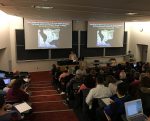Dr. Ra’anan Boustan of Princeton University delivers the Itta and Eliezer Zeisler Memorial Lecture at the University of British Columbia on March 23. (photo by Gregg Gardner)
A mosaic from Late Antiquity has lessons for Jewish communities today. According to Dr. Ra’anan Boustan of Princeton University, “Jewish identity, historically, was broader, more porous, and integrated more non-Jewish elements than we might think, and, likewise today, we should not hasten to essentialize or rigidly define Jewish identity or culture.”
Boustan offered this insight when delivering the Itta and Eliezer Zeisler Memorial Lecture at the University of British Columbia on March 23. Called Greek Kings and Judaean Priests in the Late Antique Synagogue: The Newly Discovered “Elephant Mosaic,” Boustan’s visit was presented by the Archeological Institute of America, Vancouver Society, and co-sponsored by the UBC Diamond Chair in Jewish Law and Ethics, and the department of classical, Near Eastern and religious studies (CNERS).
A 2011 dig led by archeologist Jodi Magness excavated several sections at the site of a former village, Huqoq, near the Sea of Galilee. Among the items uncovered was a mosaic that is said to have adorned the floor of an elaborate 1,600-year-old synagogue.
“The discovery of the mosaic was a major find,” Prof. Gregg Gardner of CNERS told the Jewish Independent. “There are very few mosaics from the ancient world that depict biblical scenes.”
The mosaics’ scenes include Samson fighting the Philistines, Noah and the flood, the destruction of the Egyptian army in the Red Sea, and others. A particularly noteworthy element is that the mosaics also show images from Greek history and mythology. “This confluence of biblical and Greek imagery was quite surprising,” said Gardner.
Boustan was in Vancouver to talk about the “Elephant Panel,” which depicts a battle between unknown actors. Although some have argued that the panel represents Alexander the Great, Boustan interprets the mosaic as the depiction of a Seleucid attack on Jerusalem led by King Antiochus VII in 132 BC. “It shows they had a sense of historical connection to predecessors in a more robust way than we might have expected, and wanted to have that memorialized in synagogue art. This shows a historical consciousness, not just the timeless world of rabbis and scriptural interpretation developing in the Talmud of the same period.”
Boustan is a specialist in Judaism in Late Antiquity (circa 200-700 CE) who has focused particularly on understanding “extra-rabbinic culture,” the Judaism that existed outside of what was preserved in the narratives of the rabbis. “The rabbinic writings – the Talmud, the Midrash – preserve the world through their eyes, what they thought was important and how they wanted things to be viewed. The rabbis did not represent all Jews or all Judaism, and the wider Jewish world may have had different viewpoints and priorities.”
Boustan has focused on studying the piyyutim (hymns) written and preserved outside the rabbinic canon and containing some unusual theological ideas, as well as on apocalyptic and mystical literature, which flourished on the fertile edge between Jewish and non-Jewish cultures.
“The mosaic is important for understanding the history of Jews and Judaism and gives us something to think about in terms of Jews living in the Western world today,” he said, noting the broader and more porous nature of Jewish identity in those times, and how we shouldn’t be in a hurry to “rigidly define Jewish identity or culture.”
For example, Boustan explained, “The figural art we are finding at Huqoq and elsewhere upends some of our assumptions that, classically, Jews didn’t do that. In fact, we’ve found many small villages of one to two thousand habitants who built very expensive buildings containing a mixture of folk art and world-class art. In Huqoq, the art is imperial-quality work, which would not be surprising to find in a major landowner’s villa in Antioch. Yet, there it is, being commissioned, paid for and used by a farming village of maybe 2,000 people. That tells us we have a lot more to learn about the Jews of Late Antiquity.”
He noted, “In addition, the synagogue art contains a zodiac wheel with a figure of the sun god, Helios, in the centre. What’s going on there? Is it just a decoration? Was it actually part of religious worship in the synagogue? Was it seen allegorically as a poetic representation of God?
“Helios imagery was adopted by Christians in the third century, along with many other Greek religious symbols,” he said. “As the Greco-Roman world Christianized, however, they distanced themselves from ‘pagan’ imagery. By the late fourth to seventh [century], Jews are the only ones actively cultivating zodiacal and Helios imagery. Ironically, if you find a building with Helios imagery from that period, it’s almost definitely a synagogue.”
The mosaics can be viewed in detail at nationalgeographic.org/news/huqoq-excavation-project.
Matthew Gindin is a freelance journalist, writer and lecturer. He writes regularly for the Forward and All That Is Interesting, and has been published in Religion Dispatches, Situate Magazine, Tikkun and elsewhere. He can be found on Medium and Twitter.

